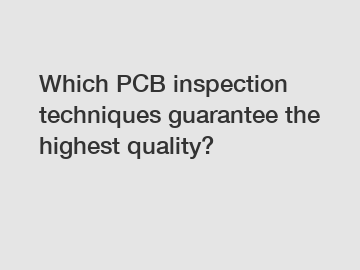Dec. 23, 2023
Machinery
zhengye supply professional and honest service.
Which PCB inspection techniques guarantee the highest quality?
When it comes to ensuring the highest quality of printed circuit boards (PCBs), it is essential to employ effective inspection techniques. The inspection process not only helps detect defects and faults but also ensures that the PCBs adhere to industry standards and specifications. Various techniques can be utilized for PCB inspection, including automated optical inspection (AOI), X-ray inspection, and functional testing.

AOI is a widely adopted technique that utilizes optical cameras and advanced algorithms to inspect PCBs for defects like missing components, incorrect component placement, soldering issues, and solder bridge connections. By capturing images of the PCB and comparing them to a reference image, AOI systems can detect even minor deviations and abnormalities. This technique is particularly useful for high-volume PCB production, as it enables fast and accurate inspections without human error.
X-ray inspection, on the other hand, is commonly used for examining the internal structure of PCBs without causing any damage. It is particularly effective in identifying faults like hidden solder joints, short circuits, open circuits, voids in solder joints, and component misalignment. X-ray inspection is especially beneficial for complex PCBs with multiple layers and fine-pitch components, where visual inspection alone may not be sufficient. By providing a non-destructive way to detect internal defects, X-ray inspection significantly contributes to improving the overall quality and reliability of PCBs.
Lastly, functional testing plays a crucial role in guaranteeing the highest quality of PCBs. This technique involves testing the PCBs in a simulated operational environment to ensure that they function as intended. Functional testing can help catch defects that may not be identified during visual inspection, such as intermittent faults, faulty connections, and incorrect functionality. By subjecting the PCBs to rigorous testing, manufacturers can strengthen their confidence in the quality and performance of their products.
The utilization of these PCB inspection techniques brings several invaluable benefits to the manufacturing process. Firstly, they help identify and rectify defects early in the production cycle, reducing the likelihood of costly rework or product failure in the field. Secondly, these techniques enable higher levels of automation, resulting in increased efficiency and productivity. Thirdly, by ensuring the adherence to industry standards and specifications, PCB inspection techniques contribute to the delivery of consistently high-quality products to customers.
In conclusion, the use of effective PCB inspection techniques, such as automated optical inspection, X-ray inspection, and functional testing, is instrumental in guaranteeing the highest quality of printed circuit boards. These techniques not only detect defects and faults but also contribute to improved productivity, reduced costs, and enhanced customer satisfaction. By investing in robust inspection processes, manufacturers can ensure the reliability and performance of their PCBs in various applications.
You can find more information on our web, so please take a look.
Are you interested in learning more about Legend Inkjet Printing Machine? Contact us today to secure an expert consultation!
If you are interested in sending in a Guest Blogger Submission,welcome to write for us!
All Comments ( 0 )